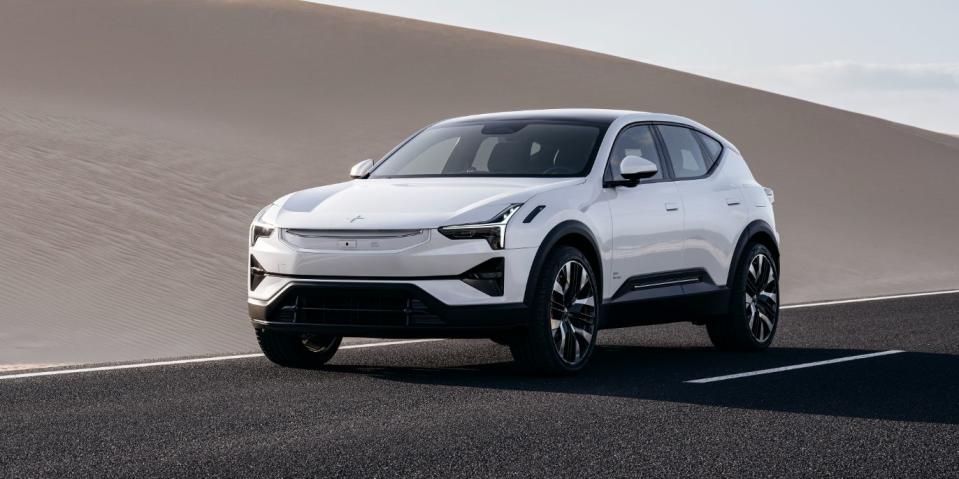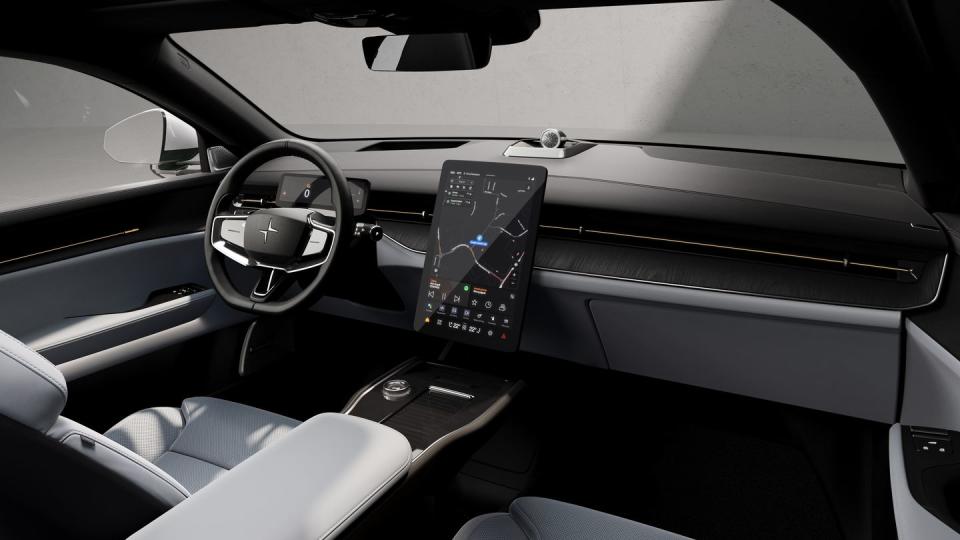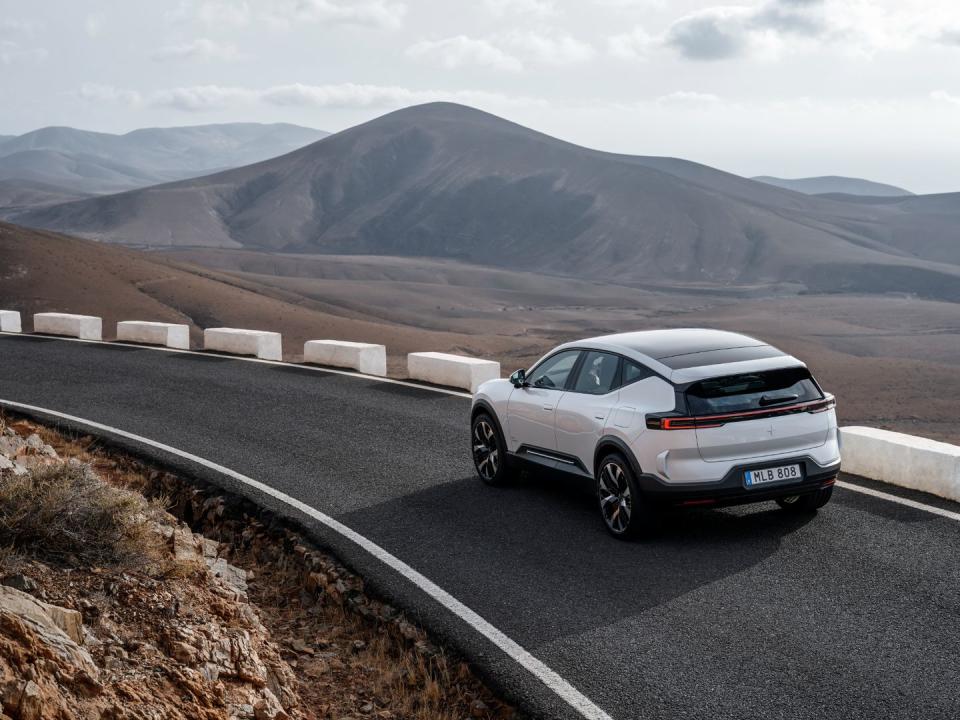The 2024 Polestar 3 SUV Could Be the Smartest Car on the Road

The 2024 Polestar 3 SUV is finally revealed, to be launched on a shared EV platform with Volvo at the starting price of $85,300.
It comes with 300 miles of EPA-estimated range, 489 hp, and 620 lb-ft of torque; a host of artificial intelligence and driver-assistance technologies are standard.
Manufactured in two separate plants (Chengdu, China, and Ridgeville, South Carolina), deliveries for North American markets are set for late 2023.
After nearly a year of teasers, Polestar is finally revealing the production version of its flagship EV SUV, the Polestar 3. With a focus on sustainability, luxury, and safety, the new SUV model is set to be the company's most advanced offering, and also the most expensive. Here's everything you need to know about the new 2023 Polestar 3.
While it's possible Polestar will expand the model range later, the shared Volvo-platform Polestar 3 will only be available in a long-range, dual-motor configuration at launch. Pricing will start at $85,300, with an optional $6000 performance pack. That's a high price tag, but first-model-year cars are being manufactured with the highest level of standard equipment available. Both the Plus and Pilot pack will be a bonus for early model adopters, featuring a 25-speaker audio system from Bowers & Wilkins, a Pilot Assist driver-assistance system, and heated interior components.
Mechanically, all Polestar 3 models will be the same, at least for now. Using a 400V lithium-ion, 111-kWh battery pack, the Polestar 3 has an estimated driving range of up to 610 km WLTP rated, or an EPA-estimated 300 miles of range. This exceeds the standard for range within the company, currently set at 260 miles (EPA) with the Polestar 2 Dual Motor, and moves Polestar closer to Tesla range territory.
On the charging front, the Polestar 3 will have a maximum DC charge rate of 250 kW. A mechanical heat pump is standard on the Polestar 3, using ambient heat for cabin climate and battery preconditioning and helping the battery stay well-conditioned over its lifespan. Polestar says the model will be equipped with bi-directional charging.

Power numbers start at 489 hp and 620 lb-ft of torque, though the optional Performance Pack raises output to 517 hp and 671 lb-ft. That rockets the 5000-pound SUV to a 0-60 mph time of 4.6 to 4.9 seconds, depending on the package, and a top speed of 130 mph.
Similar to the system featured on the Polestar 2, drivers can adjust the regenerative braking settings to their liking, with a one-pedal drive mode available. The rear electric motor can even decouple to provide a more economical drive using just the front motor.
Falling in line with the SUVs of our time, the Polestar 3 was built with dynamics in mind. ZF-provided dual-chamber air suspension is present on all Polestar 3 models and can be adjusted between comfort and dynamic characteristics, with the electronic control module allowing for adjustments every two milliseconds.
Brembo was enlisted to provide the braking hardware—with a set of 4-piston, 400-mm ventilated discs up front and single-piston, 390-mm ventilated discs out back—to slow down all 5696 pounds (lightest spec). The heaviest Polestar 3 weighs in at 5886 pounds. Despite the weight, the model does have a 50:50 front/rear weight distribution, allowing for a more balanced handling character.
Where the new Polestar is really likely to shine is in its technology. An artificial-intelligence brain will be the centerpiece of the model, with a centralized computing system from NVIDIA monitoring five radar modules, five external cameras, and 12 external ultrasonic sensors. These sensors and cameras work to help drivers avoid a collision, detect obstacles, and even steering the vehicle when using the Pilot assistance system.
An interior system also tracks the eye movement of the driver, alerting the driver of distracted or drowsy habits. A LiDAR-based Pilot assistance system will become available in the second quarter of 2023, which further develops the car's autonomous driving potential.

The 14.5-inch center display infotainment system is driven by the Snapdragon Cockpit Platform from Qualcomm Technologies and features an Android Automotive OS with Google system built in. If it's anything like the system in the new Polestar 2, that means Google Maps will work with the car to help you track your range to and from a destination. Over-the-air updates are available and will be encouraged, per Polestar's press materials.
The interior of all Polestar 3 units will be relatively standard, with a full-length panoramic glass roof, all-LED lighting inside, and sustainability-sourced seat materials. Specifically, Polestar says it used MicroTech upholstery, animal welfare-certified leather, and fully traceable wool upholstery in creating its interior touch points.
Orders are currently open for the launch model, and Polestar says it expects the first deliveries to occur in late 2023 or early 2024, depending on the plant. These models will be manufactured in two different plants, depending on the market, with Volvo's facilities in Chengdu, China, and Ridgeville, South Carolina, preparing for production. US model cars are slated for release in 2023, though global deliveries are set for 2024.
Has Polestar created a precedent for the ideal performance electric SUV? Please comment below.

 Yahoo Autos
Yahoo Autos 